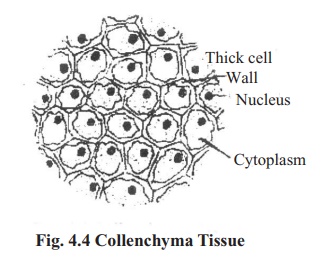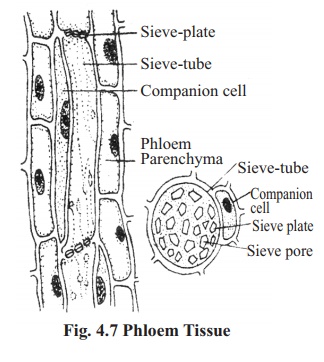Chapter: Biology: Division of Labour In Multicellular Plants : Tissue and Tissue System
Types of permanent tissue
Types of permanent tissue :
Permanent tissues
are of three types,namely -
(a) Simple tissue,
(b) Complex tissue
and
(c) Secretory
tissue .
(a) Simple tissue: Tissues of same kinds compose simple tissue.
Simple tissues are of three types, namely
i. Parenchyma: Characteristics of parenchyma tissue are as follows:
· Cells are almost uniform in length, breath and depth.
· Cells are round, oval or polygonal in shape.
· Cell wallls are evenly thick.
· Cells are living and contain sufficientprotoplasm.
·
There may have intercellular spaces between
adjacent cells
Permanent - tissues that Thin cell wall contain chlorophyll are
called Chlorenchyma. The
chlorenchyma ofleaf IS called Messophyll.
Parenchymatous tissues with large air spaces In aquatic plants are Aerenchyma.

Functions:
Chlorenchyma manufactures food materials. They store reserve
food.
They help ,in transporting the food materials. Parenchyma in the
epidermis act as a defensive organ.
Position: Usually pith, pith rays, epidermis and most of the cortex are
made ofthis tissue.
ii. Collenchyma: Characteristics of collenchyma tissues are asfollows:
·
Cells are to some extent elongated.
·
Cells are living with protoplasm.
·
Cell wall is unevenly thick,
thickness is greater at eorners of the cells.
·
There may have intercellular spaces
between adjacent cells

Functions:
·
Cells with chlorophyll
manufacturefood.
·
It gives mechanical strength ' to the
growmg organ.
Position: It is found under the epidermis, in the petioles and veins of
leaves and in the flower stalks.
iii. Sclerenchyma: Characteristics of
Sclerenchyma are as follows:
Cells elongateq and the ends are pointed.
Cell walls being lignified become thick and the thickness is
uniform.

Mature cells are dead and without nucleus and protoplasm.
In transverse section they are polygonal. Functions:
To give mechanical strength to different organs of the plant is
the main function.
Some dead cell may store excretory substances of plants. Sometimes
it forms hard outer wall to protect the inner soft portion, e.g. seeds of
coconut and date-palm
(b) Complex tissue:
Complex tissue is composed of more than one kind of cells. They
are two types, namely Xylem tissue
and Phloem tissue.
i. Xylem tissue: Xylem tissue consists
of four types of cells, namely:
Tracheids, Vessels or Trachaea, Xylem fibre and Xylem Parenchyma.
Tracheids: Cells are dead, long withtransverse ends, containing large
vacuole. Cell walls are hard, strong. and lignified. Their main functions are
to gIve mechanical strength and to supply water and dissolved minerals from
root to the leaves.
Vessels or
Trachaea: Cells are broadand
short, placed end to end to form a continuous hollow tube. Water and
waterdissolved minerals are conducted from root to leaf by these cells.

Xylem fibre: These are sclerenchymatouscells. Their main function is to
give mechanical strength to the plant.
Xylem parenchyma: These areparenchymatous .cells. Functions of these cells
are storage and conduction of food materials.
Functions of xylem
tissue: Theirfunctions are
to give mechanical strength to the plant body, conduction of water, minerals
and food materials and storage of food.
ii. Phloem tissue: Phloem tissue consists offour types of cells, namely:
sieve tubes, companion cells, phloem fibres and phloem parenchyma.
Sieve tube: These are elongate hollowcells placed end-to-end forming.

Division of Labour in Multicellular Plants a long tube.
The partition walls between two adjacent sieve cells are perforated and known
as sieve plate. In m4;iture sieve tube there is. no nucleus in the cell.
Conduction of food, prepared in the leaves is its main function.
Companion cells: These are parenchymatous, narrow, elongated cells, andare
closely associated with the sieve tube. They have dense cytoplasm and a large
nucleus. Conduction with the sieve tube is done through the pores present on
the walls of these cells. They help the sieve tubes in conduction of food
materials.
Phloem fibre: These are Sclerenchymatous cells. They are
also known as bast fibre. Its function is to give mechanical strength.
Phloem parenchyma: These are parenchymatous cells. They help in storageand
conduction of food materials.
Function of Phloem
tissue:
There main function is to conduct food materials, prepared
in the leaves, to different parts of the plant.
They give mechanical strength to plant organ.
In case of necessity they store food materials.
Importance of
Complex tissues:
In respect of physiological and economic aspects, complex
tissues are of great importance.
Physiological
importance:
Complex tissues perform the duty of conduction of raw food
materials to leaves and prepared food materials to all the living cells.
Beside preparation of food, water is necessary for various
reactions. This water is conducted from root to stem through the complex tissue
named xylem.
Through xylem tissue dissolved minerals along with water
also passes upwardly.
Water used in transpiration also moves to leaf through
xylem tissue.
Economic importance
The most important economic crop in Bangladesh is jute
fiber. Jute fiber is the secondary
phloem or bast fiber.
The wood we use, in the construction of houses, in making furniture,
boat or musical instruments or as fuel, is the secondary xylem.
Secretory tissue: Secretoy tissues are those tissues, which secretsvarious
liquids, Resins, gums, rubber etc. are collected from secretory tissues. They
are of two types: .
Related Topics